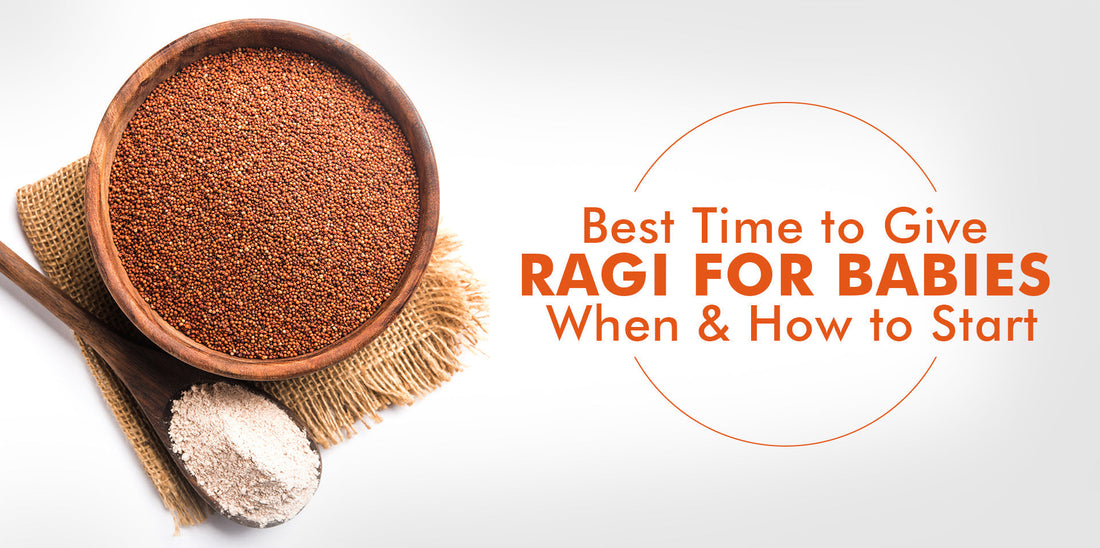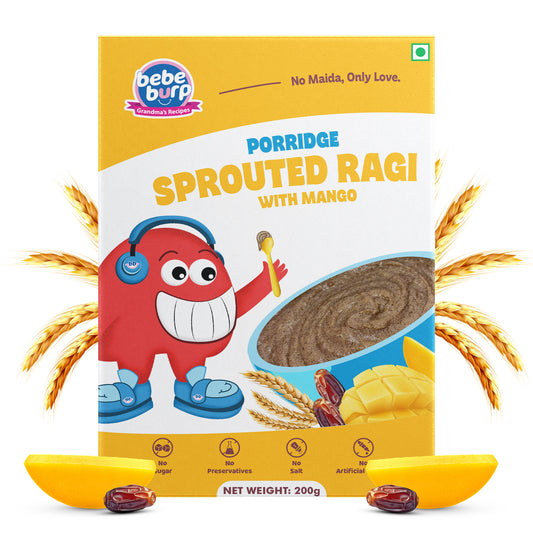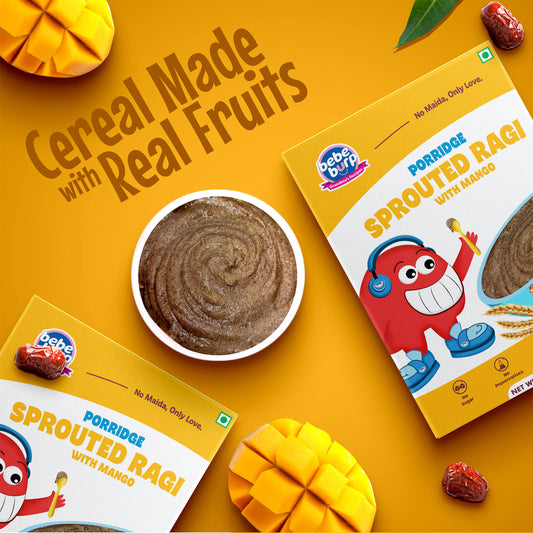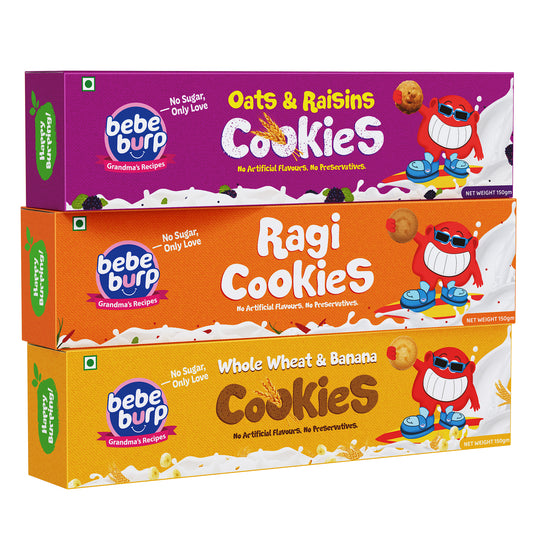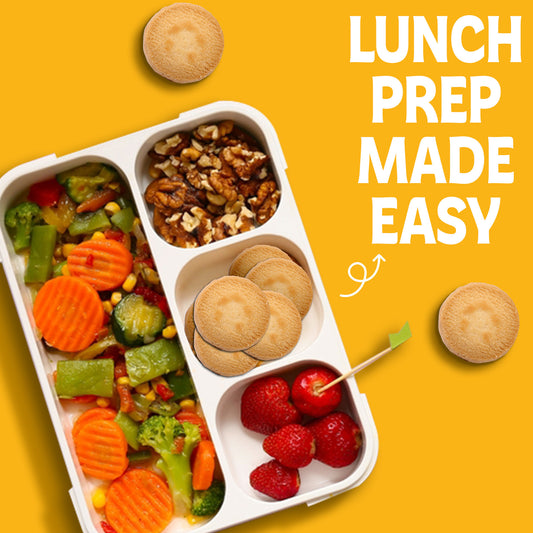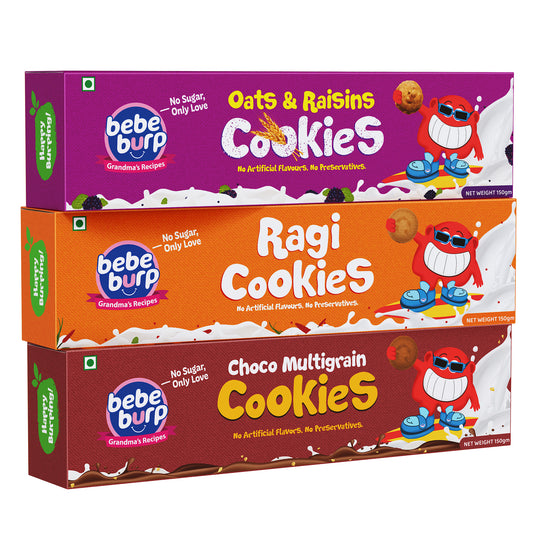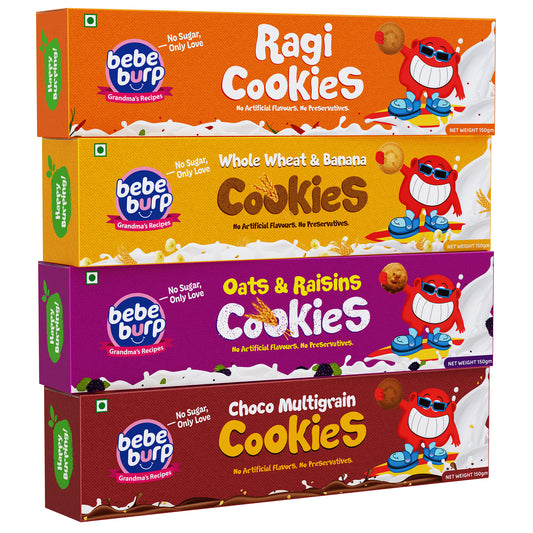Ever wondered when to start giving ragi to your baby? The simple answer is that once your child is six months old and ready to eat solids, ragi is a perfect option.
Ragi benefits for babies include being loaded with iron, calcium, and fiber, all of which are critical for development.
Ragi for Babies should be introduced slowly, starting with a small amount and increasing gradually.
When to Introduce Ragi For Babies

✔️ 6 Months+ – Infants can begin consuming ragi for 6 month baby when parents start giving solid foods to their babies. A person should begin with a refined and thin porridge texture.
✔️ 8 Months+ – You should thicken the porridge step by step while mixing ragi with banana or apple fruits.
✔️ 10 Months+ – Children at this age should try ragi khichdi as well as dosa and soft cookies.
💡 Tip: Introducing any new food requires a three-day wait before checking if your baby has an allergic reaction according to the 3-day rule.
Morning vs. Night: Which Time is Better?
✅ Morning or Lunch (Ideal Time) – Eating ragi in the morning or during lunch will help avoid night-time bloating because its ragi digestion time is longer.
✅ Not at Night – Late-evening ragi consumption results in gas and discomfort because this food contains high amounts of fiber and calcium.
Health Benefits of Ragi for infants

- Rich in Calcium: The support comes from calcium, which builds bones together while maintaining healthy teeth.
- Iron-Rich: Prevents anemia.
- High Fiber: Aids digestion and prevents constipation.
- Good for Weight Gain: A nutritious option for underweight babies.
- Immunity Booster: The ingredients contain antioxidants together with amino acids, which strengthen the immune response.
How to Prepare Ragi for Babies

Step 1: Selecting the Right Ragi
You can use:
✅ Whole ragi grains serve as an option for use (they can be transformed into sprouted ragi powder for babies then ground into flour).
✅ Ragi flour stands ready for use because it is both available commercially and convenient to prepare.
💡 Tip: The nutritional power of ragi improves after sprouting and its digestibility becomes easier through this process.
Step 2: Making Ragi Porridge Powder (Optional, for Fresh Use)
- The first step involves placing ragi grains into water for soaking time between six to eight hours.
- The sprouting occurs inside a muslin cloth for one day.
- Low-temperature dry roasting techniques should be applied to sprouted grains.
- Put the ragi grains through a grinder until they become powder then place them inside a sealed container.
The homemade ragi powder serves as an ingredient for preparing both porridge along with other baby foods.
Healthy Ragi Recipes for Babies
- Ragi Porridge – Ragi flour + water/milk + jaggery (For 6+ months)
- Ragi Banana Mash – Small children above seven months can benefit from adding bananas to their ragi porridge.
- Ragi & Apple Puree – You should blend cooked apples using ragi flour for babies 7 months and older.
- Ragi Idli – Fermented foods aid digestion (8+ months)
- Ragi Cookies – A healthy snack for teething babies (10+ months)
1. Ragi Porridge (6+ months)

A simple, smooth, and nutritious first food for babies.
Ingredients:
- 2 tbsp ragi flour
- Two tablespoons of ragi flour require one cup of water (or substitute with milk when your baby reaches eight months) to make the mixture. Optionally add one half teaspoon of jaggery for flavor.
- ½ tsp jaggery (optional)
Method:
- Create a smooth mixture of ragi flour by adding small amounts of water.
- Add the ragi paste bit by bit while continually stirring into boiling water or milk that has reached 1 cup.
- Let the mixture cook at low heat for 5-7 minutes while thickening.
- The mixture should get jaggery as needed then mix thoroughly until serving warm.
💡 Tip: A straining procedure should be used when serving porridge to babies because it helps achieve a smooth eating consistency.
2. Ragi Banana Mash (7+ months)

A naturally sweet, energy-rich food.
Ingredients:
- 2 tbsp cooked ragi porridge
- ½ ripe banana, mashed
Method:
- Mash the banana until smooth.
- Mix with warm ragi porridge.
- Serve immediately.
💡 Tip: Apple puree or pear puree make suitable substitutes for the banana.
3. Ragi Khichdi (8+ months)

A wholesome meal with lentils and veggies.
Ingredients:
- 2 tbsp ragi flour
- 1 tbsp moong dal
- The cooking dish includes ½ cup of combined vegetables that combine carrot with pumpkin and sweet potato.
- 1 tsp ghee
- 1 cup water
Method:
- Cook moong dal with veggies in water until soft.
- Mix ragi flour while stirring until smooth consistency emerges.
- Let this mixture cook at low heat for 5 minutes.
- Stir the contents after you add ghee before consumption.
4. Ragi Apple Halwa (9+ months)

A naturally sweet, soft dessert for babies.
Ingredients:
- 2 tbsp ragi flour
- ½ cup apple puree
- 1 cup water or milk
- 1 tsp ghee
Method:
- Cook the ragi flour with ghee for two minutes before proceeding.
- Add either water or milk together with the mixture until it turns thick.
- Combine the apple puree with the mixture before cooking it for an additional minute.
- Serve warm.
5. Soft Ragi Cookies (10+ months)

Perfect for teething babies!
Ingredients:
- ½ cup ragi flour
- ¼ cup whole wheat flour
- 2 tbsp jaggery powder
- 2 tbsp ghee
- ¼ tsp baking soda
- 2 tbsp milk
Method:
- Stir all components until they generate a pliable dough.
- The small-shaped cookies need 180°C oven heat for 12-15 minutes until baked.
- Cool completely before serving.
Safety Tips & Precautions for Feeding Ragi

- Ragi's Three Day Rule: For Ragi, new users need to follow the three day introduction rule.
- Bright Watered Down Stew: First, try a thin broth-based stew.
- Absent Sweeteners: Do not introduce sweeteners before a child turns one year old.
- Sufficient Water: Since ragi is a little on the heavier side make sure your child is drinking sufficient water.
FAQs About Ragi for Babies
Q1: Does ragi give you gas or constipation?
Ans: Ragi doesn’t cause gas or constipation. Ragi is exceptionally healthy and boasts an abundance of fiber which helps ease constipation.
If constipation does happen, one should drink plenty of water.
Q2: Can it be consumed daily?
Ans: Moderate use is good. Ideally, once every four to five days is perfect.
Q3: Can it cause a cold or sneeze?
Ans: Ragi is not known to cause a cold. However, in case your child is prone to allergies, you may add dry ginger or ajwain with ragi to provide extra protection.
Conclusion
Ragi is highly nutritious for babies, and it is best given in the morning. It can be introduced in the form of tasty recipes and porridge.
As always, ensure allergy checks and proper hydration.
It is deeply beneficial for your little one’s growth and health while being incredibly tasty!

